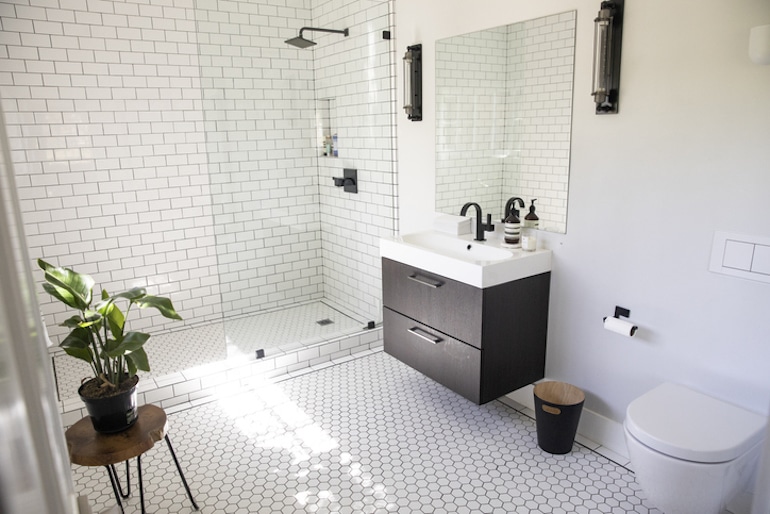Gaby Vaca-Flores, RD, CLE, gets *to the bottom* of what different types of poop mean. Included: what their consistency, color, and frequency say about your digestive and overall health.
Have you ever asked yourself: Is my poop normal?
Maybe you’ve noticed that sometimes it has a different shape or color. Otherwise, you might find that it’s easy (and dare I say, enjoyable) to pass—while other times, not so much.
Don’t worry; you’re not alone! We’ve all had these thoughts. Now we’ll dish all about the different types of poop and what they mean. After all, poop can be one of the best indicators of digestive health.
WHY Poop Type Matters
Keeping an eye on your poop may not sound like the most pleasant piece of advice, but the importance of good bowel health can’t be stressed enough.
Poop can tell us a lot about what may be going on with your digestive system. Moreover, it can paint a broad picture of your health status, given that 70 percent of the immune system resides in the gut.
As a result, we often rely on the texture, shape, color, timing patterns, and even the smell of poop to give us small clues for what may be going on with your body.
WHAT DOES HEALTHY POOP LOOK LIKE?
We’re all unique—even when it comes to our poop. Normal poop can vary among individuals for several reasons, including dietary habits, supplement intake, and activity levels.
Healthy poop is about 75 percent water and a 25 percent mixture of protein, fats, bacteria, fiber, mucous, and cells.
To classify normal poop texture, health professionals use a widely accepted indicator known as the Bristol Stool Scale. This chart helps us break down the seven main types of poop and what they mean exactly.
The Different Types of Poop, According to Consistency
According to the Bristol Stool Chart, there are seven main types of poop, some of which resemble each other.
Here’s a quick guide what your poop’s consistency means.
Firm or Marble-Like
This consistency is more difficult to pass and may indicate constipation.
Many factors contribute to constipation. Some of the best ways to relieve constipation include increasing fiber intake, eating magnesium-rich foods, and taking regular bathroom breaks.
Smooth, Sausage, or Snake-Shaped
This consistency is easy to pass and indicates a healthy, normal poop. A sausage-shaped poop with some visible cracks that’s easy to pass is the gold standard. A smoother poop that’s snake-shaped is also considered normal.
Tip: Managing your stress levels can help you achieve more normal poops and improve gut health.
Soft or Mushy
This consistency starts to indicate mild diarrhea. It can range from being easy to pass or with a more urgent need to pass.
If you’re prone to this type of poop, be sure to stay hydrated. Also, prize eating whole foods instead of processed or spicy foods.
Liquid
A fully liquid poop indicates diarrhea. You’ll likely feel a strong urgency to pass. This can cause dehydration.
In addition to the advice for soft/mushy poop above, you may want to follow an elimination diet to discover any sensitivities.

What does the color of your poop mean?
Food, supplements, and some medications are the main influences behind color variations in your poop.
Brown Poop
Bile content in poop is an overlooked contributor to color.
Bile is a fluid created by and released from the liver. Its main function is to help break down fat from our diet, but it can also help your body get rid of toxins.
Bile’s slight yellow/green hues, coupled with colors from the foods you eat and the supplements or meds you take, can create poop that’s many different shades of brown, and sometimes green. This type of poop is considered normal.
Green poop
On the flip side, too much bile in the poop can cause a strong green hue.
In most instances, this is because food is simply moving through the digestive tract too fast. This leaves the bile too little time to break down dietary fats.
Overeating, stress, and gut microbiome imbalances are commonly responsible for green poop. However, frequent green poop can sometimes be related to more serious conditions.
For some, green poop can also indicate a high-vegetable diet or a diet high in green food coloring. In these cases, green poop is acceptable as long as it happens sparingly, such as following a jump in your veggie intake.
Black poop
Iron supplements and OTC meds are often the culprits behind black stools. Surprisingly, eating black licorice can also cause stools to darken.
On the other hand, black, tar-like stool with a strong odor can indicate more serious health issues that should be looked into by a doctor.
Red Poop
The presence of blood in poop is the main reason why it can appear red. Most often, it’s related to constipation. Constipation is generally the result of a diet low in fiber, whole foods, and water.
Additionally, some women may also experience red-colored poop during their period. Next, a less common reason for red stool is eating foods with strong red hues, such as beets and drinks with red food dye.
If none of these reasons apply and you frequently experience red stools, check in with your doctor right away.
Pale-Colored Poop
Light yellow, gray/clay-colored, and very light brown stools often indicate that your gut function is off. In this case, consult your doctor ASAP.
How Often Should I Poop?
Knowing how frequently you pass stool is just as important as knowing its type and color. However, there’s no definitive or ideal number of times for how often a healthy person should poop.
According to a Healthline survey of 2,000 participants, almost half reported pooping once daily, with only a quarter of them reporting that they poop twice daily.
Generally, pooping one to three times per day is a good goal for most people. It should also be noted that normal poops are fairly easy and quick to push out. For instance, it should typically take less than a minute or two to pass a healthy bowel movement.
Lastly, people experiencing constipation may find that they have less than three bowel movements per week. They may also experience pain and discomfort in the process.
WHEN TO SEE A DOCTOR
Still wondering if your poop is normal? If any or all of these three indicators apply to your poop, then it’s best to see your doctor.
- Foul smell: Most poop smells unpleasant. However, strong foul-smelling poop may be a sign of underlying health issues.
- Unusually colored poop: This can be a sign that something may not work as it should. Simply put, pay special attention for red, black, and yellow/pale stools that are generally unrelated to food, supplement, or medication intake.
- Infrequent bowel movements. If you often have difficulty going at least once per day, it’s best to see a doctor or registered dietitian to make appropriate dietary and activity modifications.

TIPS to SUPPORT HEALTHY Poops
Now that you what different types of poop mean, the goal is to get you to have regular, healthy bowel movements.
All things considered, consistently practicing healthy habits will support better poops. As a dietitian, I recommend the following pieces of advice:
1. Create a distraction-free environment by limiting phone or tablet usage while on the toilet.
2. Define your normal. As mentioned earlier, everyone’s own version of normal poop may vary. Be in tune with what looks healthy for you on most days.
3. Eat a diet rich in high-fiber foods like whole grains, vegetables, fruits, and beans. On average, men should aim to eat 38 grams of fiber daily and women should aim for 25 grams daily.
4. Optimize your gut and digestive health by nourishing your gut microbiome with good bacteria. We like incorporating a daily probiotic and drinking fermented foods and drinks.
5. Make sure to hydrate on a daily basis with plenty of H2O and water-rich fruits like cucumber, watermelons, apples, and pears.
6. Since a sedentary lifestyle may let things get stuck or backed up, be sure to exercise to help move things along.
source https://betterweightloss.info/an-rds-guide-to-what-different-types-of-poop-mean/


No comments:
Post a Comment